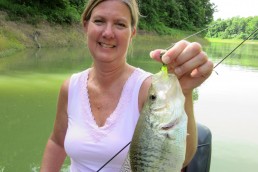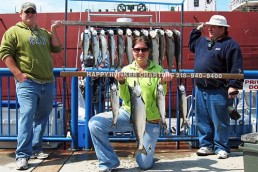Spring Sauger Tactics for River Fishing
SHARE THIS POST
Rivers can be a difficult challenge for those who are beginning walleye anglers. Water level, clarity and temperature, which can change depending upon unpredictable weather patterns, are all lessons to be learned.
Rising water can be there one day and falling the next, while clean water can be there one day, then dirty and then clean again. Rising temperatures will trigger fish movement upstream, toward spawning areas then back again. In addition, cold fronts with severe weather can put a halt to the action.
Even with these challenges, springtime walleye and sauger action can be excellent. After years of fishing the Illinois River, we would put it up against many of the top sauger spots in the Midwest. There are few places with the chances of catching fish over 3 pounds.
The presence of Asian carp on the Illinois River has changed the approach a bit. You will want to stay between the buoys in deeper water when you run from spot to spot because the troublesome carp like to jump at passing boats and seem to concentrate in shallower water.
The Illinois River is a leader for the saugers over the walleyes, with the Mississippi River heavier with walleyes than saugers. Although general locations for the two are similar, there are noticeable differences in an approach.
Focus on current seams
Walleyes and saugers behave in similar ways. Understanding how fish adapt to living in rivers is the key to pinpointing location. Walleyes and saugers conserve energy to grow and reproduce. As a result, both gather behind any natural or man-made current break that offers rest and an area to ambush food.
Movements across long, straight, river stretches are followed by rest stops at river bends, where the water slows on the inside turns. A good river map will pinpoint those spots. Look for gravel, rock, sand, clay and even clam beds. If the current or barge traffic has cut a hole in the bottom nearby where fish can rest or ambush minnows, that’s even better. Rushing water creates rolling washboard bottoms in soft sand and mud.
What you’re looking for are eddies, areas of slack water created by current breaks. They occur on the upstream and downstream sides of points. They can be upstream and downstream from neck-downs, where the two shorelines pinch together. Current also slows on the upstream and downstream sides of islands. Eddies form on either side of wing dams and when current from a tributary, feeder creek or factory discharge meets fast waters of the main river. No matter what forms an eddy, the critical place is the seam, where faster-moving water meets the slower water. Fish can hold just inside the slower water on one side of the seam and ambush food as it moves by.
Wing dams are critical structures on the Mississippi. The rocks stacked perpendicular from the shoreline running toward the channel help direct current away from the bank to slow erosion. The water rolls as it hits the face of the wing dam. Water speed slows at the base, and walleyes and saugers will tuck in where they can wait for food. Use a Humminbird with Side Imaging mode, which shows important features on wing dams that can hold fish, including trees or a hole that has opened in the face. Wing dams on river bends are usually best. Where there are three wing dams or more positioned in a row, target the first one upstream and the last one downstream. If those two don’t hold fish, move on. Precise readings of good sonar can also pinpoint transition areas between hard and soft bottoms where fish gather because of the wider variety of food available.
Are you enjoying this post?
You can be among the first to get the latest info on where to go, what to use and how to use it!
High water? Move toward the shore. Low water? Look for places that still have current. Move out toward the channel; move up toward a dam or downstream from neck-downs.
Tactics
Jigs, rigs and trolling crankbaits on lead core are all tactics that work great for catching walleyes and saugers in rivers. A key tactic is trolling with three-way rigs. You can slide upstream slower (than slip jigging downstream) and you can move through a little eddy and along a current break and have a bait in their faces longer.
Slow-troll against the current in a speed similar to a slow-walk when you’re on shore. Try putting enough weight on your three-way so that you can stay on the bottom with about a 45-degree angle between line and the water’s surface. The dropper should be approximately 8 to 10 inches long with a 4-foot leader attached to a floating, shallow- running crankbait, or a single hook or a floating jig head.
Trolling upstream with the gasoline kicker and a double crankbait setup will sometimes outfish three-ways. A 3- to 5-ounce bell sinker is attached to the dropper. A 3-to 5-foot leader goes to a crankbait clip for the first floating lure. A 1-foot leader is then tied to the rear split ring of the front lure and leads to a crankbait clip for the second lure. Use shallow-running, short-billed crankbaits. Mix up color; the clips make changing easy.
Three-way rigs are also great for fishing the front sides of wing dams. Simply position the boat upstream, let the rigs go back to the face of the dam and slide the boat from side to side to check out different parts of the dam. High water, try inside closer to the shore. Low water? Try nearer to the tip where there’s some current.
Try trolling with leadcore line when the river is at normal pool or lower, and when the debris in the water is scarce. Use medium-action rods and spool 18-pound-test leadcore on large line-counter reels that enable baits to be returned to the effective depths. Try different depths until a fish is caught, and troll with different types of deep-diving crankbaits.
Jigs are an old river standby for good reason—they work. To slip downstream with the current, choose a jig heavy enough to maintain bottom contact and keep the line straight below the boat while it moves with the current. Braided line increases the sensitivity to feel strikes and it improves hook-sets.
Get current. Throughout the walleye and sauger range, rivers are the places to be early in the year. You just might experience the best fishing you’ll have all year.
MWO
SHARE THIS POST
Did you enjoy this post?
You can be among the first to get the latest info on where to go, what to use and how to use it!
Ted Takasaki
Ted Takasaki is an International Fishing Hall of Fame professional angler who has been featured in many national outdoor magazines and television shows. Takasaki has appeared in front of thousands of angling enthusiasts and is considered one of America’s top walleye and multispecies anglers. Follow him on his Facebook page.



